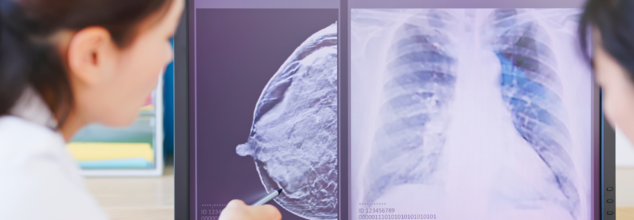- Health Conditions A-Z
- Health & Wellness
- Nutrition
- Fitness
- Health News
- Ayurveda
- Videos
- Medicine A-Z
- Parenting
- Web Stories
Breast Cancer Screenings For Women In 40s Could Be Life Saving

(Credit-Canva)
Being one of the most common cancers among women, breast cancer accounts for 30% of cancer cases in females every year. The American Cancer Society explains that breast cancer occurs in middle aged women and older women, the median age of diagnosis being 62 years of age. The average risk of developing breast cancer in women happen to be about 13%. Which means there is a 1 in 8 chance that a woman can develop breast cancer.
The best cure is prevention, and a new study shows that screening for breast cancer is the best way to tackle the disease. While there are treatments after diagnosis, they not only drastically decrease the quality of life a person is used to, but they must also go through a grueling process, with less chances of survival. One of the best ways to increase your chances of survival in breast cancer is to catch it early. However, by the time symptoms start appearing, the cancer has usually spread, which makes treating it much more difficult.
The study, published recently in Radiology Imaging Cancer, found that almost three out of four women (73%) in their 40s only discover they have breast cancer after symptoms appear. This is a significant problem because these women are less likely to survive compared to those whose cancer is found early through screening methods like mammography.
For instance, the study showed that women diagnosed due to symptoms were six times more likely to have advanced cancer, which is much harder to treat. Researchers noted that the results show patients whose breast cancers were detected because of symptoms had a 63% higher likelihood of dying.
Symptoms vs. Screening
To conduct the study, researchers tracked 821 women aged 40 and older who were diagnosed with breast cancer at The Ottawa Hospital in 2016.
They found that half of these patients (50%) were diagnosed because of symptoms (like a noticeable lump, skin or nipple changes, nipple discharge, swollen lymph nodes, or breast pain), rather than through early detection by a mammogram.
The study revealed that breast cancers detected by symptoms, rather than screening, were much more common in:
- Women in their 40s, accounting for 73% of cases.
- Women older than 75, with about 70% discovering cancer after symptoms appeared.
- The researchers also reported that deaths were higher among patients whose breast cancer wasn't caught early through screening.
Shifting Guidelines for Mammograms
This research comes at a time when both the U.S. and Canada are re-evaluating the best age for women to begin regular mammograms.
Last year, the U.S. Preventive Services Task Force updated its recommendations to suggest breast cancer screening every two years for women aged 40 to 75.
Similarly, the American Cancer Society now advises women aged 45 to 54 to get annual mammograms, with the option for women in their early 40s to start screening if they choose.
Experts noted that this difference in guidelines can impact how long Canadian women might live with undetected breast cancer. She observed a concerning trend in her own practice, seeing many women under 50 and over 75 being diagnosed only after developing symptoms.
These study results will likely bolster the push to lower the breast cancer screening age to 40 in both the U.S. and Canada. Experts mentioned that many provincial and territorial screening programs in Canada have already lowered the screening age, with a goal to establish a single national policy for screening.
An Afternoon Nap Could Cost Middle-Age People Years Of Their Life

Sleep hygiene is something we should all keep up with constantly. While you may think you can skimp on sleep, your body needs it to keep functioning properly. Not only does sleep help us make sure our body runs all its functions smoothly, but it also keeps a sleep debt. Losing an hour of sleep may not seem like much, but your body requires 4 hours more to make up for that lost hour of sleep. Understanding this, many people opt for afternoon naps that span a few hours to help them recover lost energy. However, these naps are also not all safe for your health, especially for older adults.
An afternoon nap might seem like a good idea for middle-aged and older adults, but these short rests could actually come with a significant cost. New research suggests that certain napping habits might increase the risk of an early death. These findings are expected to be presented at an upcoming meeting of the American Academy of Sleep Medicine (AASM).
Napping Patterns and Early Death
Researchers explained that people who slept longer during the day, had irregular napping schedules, or napped more around midday and early afternoon faced a greater risk. This was true even when other health and lifestyle factors were considered. These findings challenge the popular idea of the "power nap."
For the study, researchers looked at information from over 86,500 people taking part in the UK Biobank, a long-term health research project. The sleep habits of these individuals were tracked for a week using wrist devices, and then researchers compared these habits to death records. On average, the participants were 63 years old when their napping was monitored.
What Did The Research Find?
Over an 11-year follow-up period, nearly 5,200 people in the study passed away. The results showed a higher risk of dying sooner for:
- People who usually took longer naps during the day.
- Those whose napping times changed often.
- Individuals who napped between 11 a.m. and 3 p.m.
This last point goes against current AASM guidelines, which suggest that adults limit themselves to "power naps" of no more than 20 to 30 minutes in the early afternoon. Researchers noted that naps longer than half an hour can actually make you feel groggy, canceling out any potential benefits.
What Does Healthy Sleep Look Like For Different Ages
According to the Mayo Clinic, healthy sleeping patterns differ according to age. The recommendations give are,Infants (4 to 12 months): Aim for 12 to 16 hours within a 24-hour day, including naps.
Toddlers (1 to 2 years): They need 11 to 14 hours in 24 hours, including naps.
Preschoolers (3 to 5 years): Target 10 to 13 hours within a 24-hour period, including naps.
School-aged Children (6 to 12 years): 9 to 12 hours every 24 hours is ideal.
Teenagers (13 to 18 years): 8 to 10 hours within a 24-hour period is recommended.
Adults: Most adults need 7 or more hours of sleep each night.
Other Factors Affecting Your Sleep Needs
Besides age, several other things can influence how much sleep you require,
Sleep Quality
It's vital not just how long you sleep, but how soundly. Frequent interruptions mean poor quality rest. Getting truly restful sleep is equally important as the total hours.
Previous Sleep Debt
If you haven't been getting enough sleep lately, your body needs extra rest. You'll have to make up for lost sleep to feel refreshed and function well.
Pregnancy
Hormonal shifts during pregnancy can make sleep difficult. Physical discomfort also contributes to poor sleep quality, leaving expectant mothers feeling less rested than usual.
Aging
While older adults need similar sleep amounts as younger adults, their sleep patterns change. They might sleep lighter, take longer to fall asleep, wake up more often, and have shorter sleep cycles at night.
AIDS Kills One Person Every One Minute, Says UN

Credits: Canva
While AIDS-related deaths have dropped to their lowest since 2004, the world is still battling against HIV. Amid all this, a United Nations statement highlights the serious global health issue that it has become. Despite the years of progress and scientific breakthroughs, the disease still claims one life every minute, and continues to the global toll of the epidemic.
More than 30 million people across the world at this moment are receiving life saving antiretroviral treatment. As per the UN Under Secretary-General Amina Mohammed, this is a testament to the power of multilateral action. Speaking at the UN General Assembly’s review of the global AIDS response, she called it a “clear example of multilateral success.”
Impact of Funding Cuts
However behind these figures, is also a fragile system that Mohammed too stressed upon. "Global commitment is fading, funding is falling, and HIV services are being disrupted." This could undo years of hard work. The Health and Me has previously reported that the United States government also abrupted halted funding for a seminal mRNA-based HIV vaccine study, just days before its scheduled start in March 2025.
Health and Me also reported on the US' plan to freeze all foreign assistance, along with the UNAIDS, which could become a global threat for HIV cases. The UNAIDS takes up less than 1% of the overall US budget and since Trump's re-election, audits for cost-cutting and executive orders, especially in the healthcare sector has changed the shape of how aid worked before.
UNAIDS Executive Director Winnie Byanyima noted that HIV infections have in fact decreased in the recent years. In 2023, 1.3 million new cases were recorded, which is a 60% decline since the virus peaked in 1995. However, with this abrupt cut off in funding, it has created a situation of "panic, fear and confusion" in many of the African countries which are hit hardest by AIDS.
Urgent Need for Action
“We cannot let short-term cuts destroy long-term progress,” Mohammed urged. She called for the funding crisis to be treated with urgency and seriousness. In many low- and middle-income countries, healthcare budgets are being squeezed by the burden of debt servicing. In sub-Saharan Africa, half of the countries spend more on debt payments than on healthcare.
To counter this imbalance, Mohammed advocated for debt relief, global tax reform, and stronger international collaboration. She also emphasized the need for national governments to show stronger leadership and invest in sustainable HIV financing models.
Human Rights Are Health Rights
Beyond finances, Mohammed pointed to another major challenge: attacks on human rights. Marginalised groups—including LGBTQ+ individuals, sex workers, and people who use drugs—are often criminalised or face violence, hate speech, and stigma. Such punitive laws and attitudes only push people further away from testing, treatment, and prevention services.
“Protecting health means protecting human rights,” Mohammed stated, urging nations to remove discriminatory laws and support inclusive healthcare services. She also highlighted the role of community-led organizations, many of which are now facing defunding. These groups are often closest to at-risk populations and play a crucial role in delivering services, especially in hard-to-reach areas.
The Road Ahead
While the global community has made historic progress, the fight against AIDS is far from over. “The end of AIDS is not a mystery,” said Mohammed. “But success is not guaranteed.” She reiterated that with the right investments, policies, and leadership, eliminating AIDS by 2030 is still within reach—but only if the world “keeps up the fight.”
Having A Family Pet Can Decrease The Chances Of Your Kid Developing Eczema

(Credit-Canva)
Having a family pet is a favorable idea considered by many. While parents of young children are worried about bacteria and germs being an issue, there are also other factors to consider. Many studies, like ‘The Power of Pets’ published in the News in Health, have shown how pets play a very important role in a child’s development. They explain how pets have been observed to lower cortisol levels as well as lower blood pressure. They also pointed out that studies have found pets to lower the feeling of loneliness, increase social support as well, and boost your mood.
A new study shows a favorable result for families who wish to have pets, especially dogs, as they not only passively help your kid’s health, but they can also have an active effect on them.
New research suggests that having a family dog might lower a baby's chances of getting eczema later in life. This study, published on June 4th in the journal Allergy, indicates that being around dogs could actually change how a child's genes react to eczema, by calming down skin inflammation.
How Does Eczema Affect Kids?
Researchers explained that while we know genes play a role in eczema risk and that dogs might be protective, this is the first study to show how this happens at a very basic level. Eczema happens when something irritates the skin, causing it to become dry, itchy, and inflamed. We know some people are born more likely to get eczema, but exactly how their genes and their surroundings work together to either increase or decrease this risk hasn't been clear.
How Was The Research Conducted?
The researchers conducted a comprehensive analysis of data from 16 previously conducted studies. Their goal was to identify interactions between 24 specific genetic variants already known to be linked to eczema and a list of 18 environmental factors that could potentially influence a baby's susceptibility to the condition later in life.
which included over 25,000 people, narrowed down the environmental factors to seven key ones: antibiotic use, owning a cat, owning a dog, breastfeeding, having an older sibling, smoking, and hygiene.
Dogs, Genes, and Inflammation
The team then applied these findings to data from another 254,000 people to see which genes and environmental factors had the biggest impact on eczema risk. This second look found that a baby's exposure to dogs affects the interleukin-7 gene. This gene is involved in making a type of immune protein that helps control inflammation. Lab tests showed that being around dogs interacts with a gene variation that might otherwise cause eczema, essentially reducing skin inflammation by changing how interleukin-7 proteins work in human skin cells.
The experts explained that their research aims to answer common questions parents ask, like "Why does my child have eczema?" and "What can I do to protect my baby?" While these findings are exciting, the researchers also stressed that more studies are needed to confirm what they found in the lab and to better understand exactly how dogs might affect human genes in this way. Researchers believes these findings give us a chance to tackle the rise of allergic diseases and protect future generations.
© 2024 Bennett, Coleman & Company Limited

